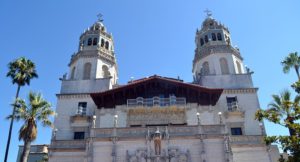The “New” Hearst Castle Brings Old Temptation

This four-level, 38,000-square-foot mansion is listed at a cool $250 million, making it the most expensive home in the United States.
Indeed, with 12 bedroom suites, 21 bathrooms, five bars, three gourmet kitchens, a 40-seat movie theater and a bowling alley, it sounds more like a hotel than a house.
Nor does it stop with those amenities, since it comes with a seven-member staff and a fleet of exotic and vintage cars. It all bears a striking resemblance to the Hearst Castle’s bowling alley, theater and solid-gold fixtures.
Enjoying Life
The developer who built it on spec told a reporter it didn’t make sense for people to be spending $350 million on a yacht or $100 million on a plane, but only living in a home worth $20-30 million.
The capping comment was his closing one: “When a person sitting with $2 billion, $5 billion or $20 billion in the bank and it’s just a number, do they really want to enjoy every second of their life—because this isn’t rehearsal, this is real life—or do they just want to look at a number in the bank?”
My question to that is, “Does he really think that a bigger home, exotic cars and an unending array of expensive toys are the ticket to happiness?”
I remember the time I interviewed a doctor who once owned enough cars to drive a different one every day of the week. He described the vast sense of emptiness he felt over this “achievement,” an apt illustration of the fleeting nature of materialism.
Dustbin of History

Will it occupy the same (figuratively speaking) space as Hearst’s early 20th century creation—so expensive to maintain that it wound up in the state’s hands? An interesting slice of history, but one that ultimately vanished into mere memories?
Sure, it’s fascinating to inspect the fixtures in the Hearst Castle’s bathrooms, survey the breathtaking views of the Pacific Ocean, and imagine hob-knobbing with the rich and famous, but what value does such self-indulgence offer the world?
Gaining the World
Interestingly, the day after I read about the modern-day version of the Hearst Castle, our morning devotions focused on 1 Timothy 6, where Paul warns that those craving riches fall into temptation and many foolish lusts.
Verse 10 notes: “For the love of money is the root of all evil. While coveting after money, some have strayed from the faith and pierced themselves through with many sorrows.”
I believe there’s in a lesson in there for all of us. It’s easy to point a finger at a $250 million mansion and talk about how over the top that is and rationalize that “I would never be tempted to own that.”
Maybe not, but what material temptations are we susceptible to? Because they are on a smaller scale doesn’t somehow make them more honorable or less enslaving.
As a wise man once asked, “For what does it profit a man if he gains the whole world and loses his own soul?”


